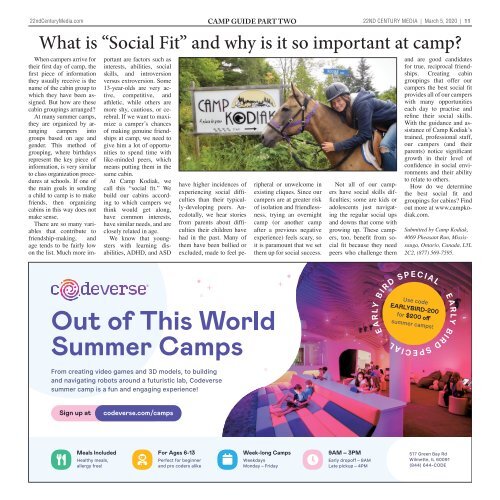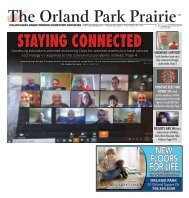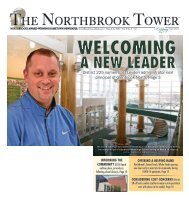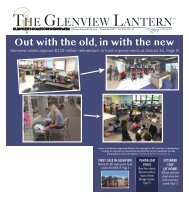Create successful ePaper yourself
Turn your PDF publications into a flip-book with our unique Google optimized e-Paper software.
22ndCenturyMedia.com camp guide part two<br />
22nd century media | March 5, 2020 | 11<br />
What is “Social Fit” and why is it so important at camp?<br />
When campers arrive for<br />
their first day of camp, the<br />
first piece of information<br />
they usually receive is the<br />
name of the cabin group to<br />
which they have been assigned.<br />
But how are these<br />
cabin groupings arranged?<br />
At many summer camps,<br />
they are organized by arranging<br />
campers into<br />
groups based on age and<br />
gender. This method of<br />
grouping, where birthdays<br />
represent the key piece of<br />
information, is very similar<br />
to class organization procedures<br />
at schools. If one of<br />
the main goals in sending<br />
a child to camp is to make<br />
friends, then organizing<br />
cabins in this way does not<br />
make sense.<br />
There are so many variables<br />
that contribute to<br />
friendship-making, and<br />
age tends to be fairly low<br />
on the list. Much more important<br />
are factors such as<br />
interests, abilities, social<br />
skills, and introversion<br />
versus extroversion. Some<br />
13-year-olds are very active,<br />
competitive, and<br />
athletic, while others are<br />
more shy, cautious, or cerebral.<br />
If we want to maximize<br />
a camper’s chances<br />
of making genuine friendships<br />
at camp, we need to<br />
give him a lot of opportunities<br />
to spend time with<br />
like-minded peers, which<br />
means putting them in the<br />
same cabin.<br />
At Camp Kodiak, we<br />
call this “social fit.” We<br />
build our cabins according<br />
to which campers we<br />
think would get along,<br />
have common interests,<br />
have similar needs, and are<br />
closely related in age.<br />
We know that youngsters<br />
with learning disabilities,<br />
ADHD, and ASD<br />
have higher incidences of<br />
experiencing social difficulties<br />
than their typically-developing<br />
peers. Anecdotally,<br />
we hear stories<br />
from parents about difficulties<br />
their children have<br />
had in the past. Many of<br />
them have been bullied or<br />
excluded, made to feel peripheral<br />
or unwelcome in<br />
existing cliques. Since our<br />
campers are at greater risk<br />
of isolation and friendlessness,<br />
trying an overnight<br />
camp (or another camp<br />
after a previous negative<br />
experience) feels scary, so<br />
it is paramount that we set<br />
them up for social success.<br />
Not all of our campers<br />
have social skills difficulties;<br />
some are kids or<br />
adolescents just navigating<br />
the regular social ups<br />
and downs that come with<br />
growing up. These campers,<br />
too, benefit from social<br />
fit because they need<br />
peers who challenge them<br />
and are good candidates<br />
for true, reciprocal friendships.<br />
Creating cabin<br />
groupings that offer our<br />
campers the best social fit<br />
provides all of our campers<br />
with many opportunities<br />
each day to practise and<br />
refine their social skills.<br />
With the guidance and assistance<br />
of Camp Kodiak’s<br />
trained, professional staff,<br />
our campers (and their<br />
parents) notice significant<br />
growth in their level of<br />
confidence in social environments<br />
and their ability<br />
to relate to others.<br />
How do we determine<br />
the best social fit and<br />
groupings for cabins? Find<br />
out more at www.campkodiak.com.<br />
Submitted by Camp Kodiak,<br />
4069 Pheasant Run, Mississauga,<br />
Ontario, Canada, L5L<br />
2C2, (877) 569-7595.


















